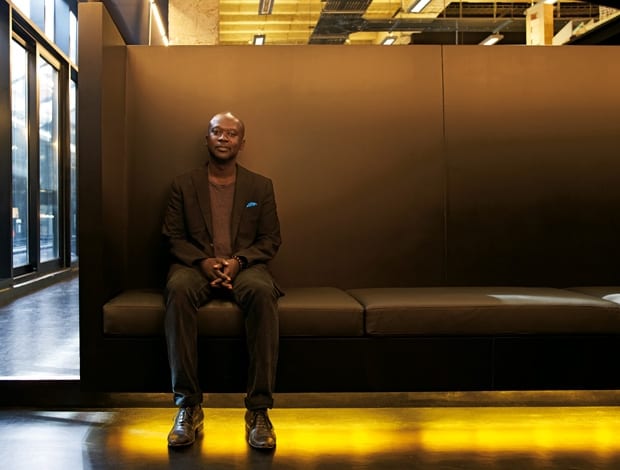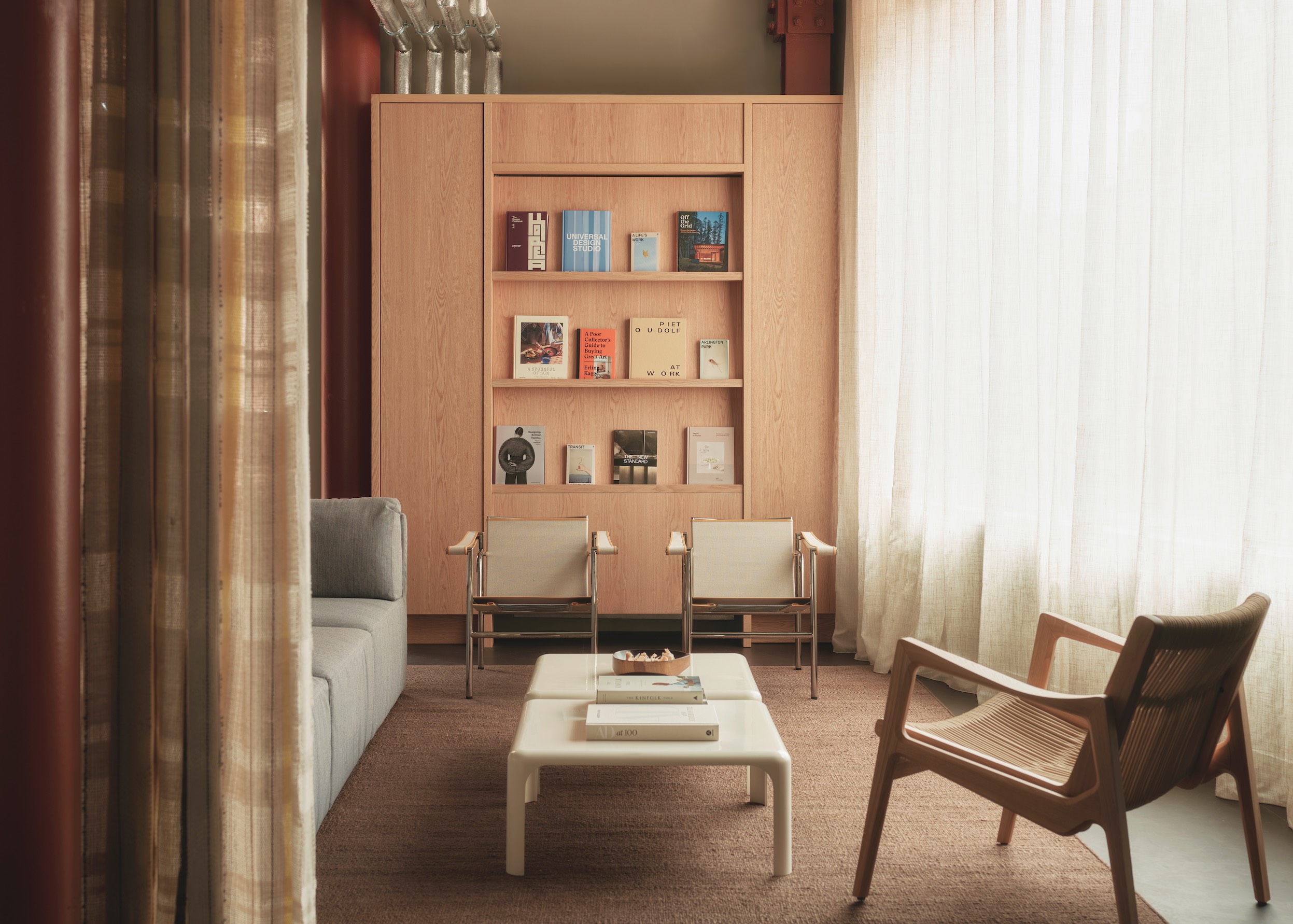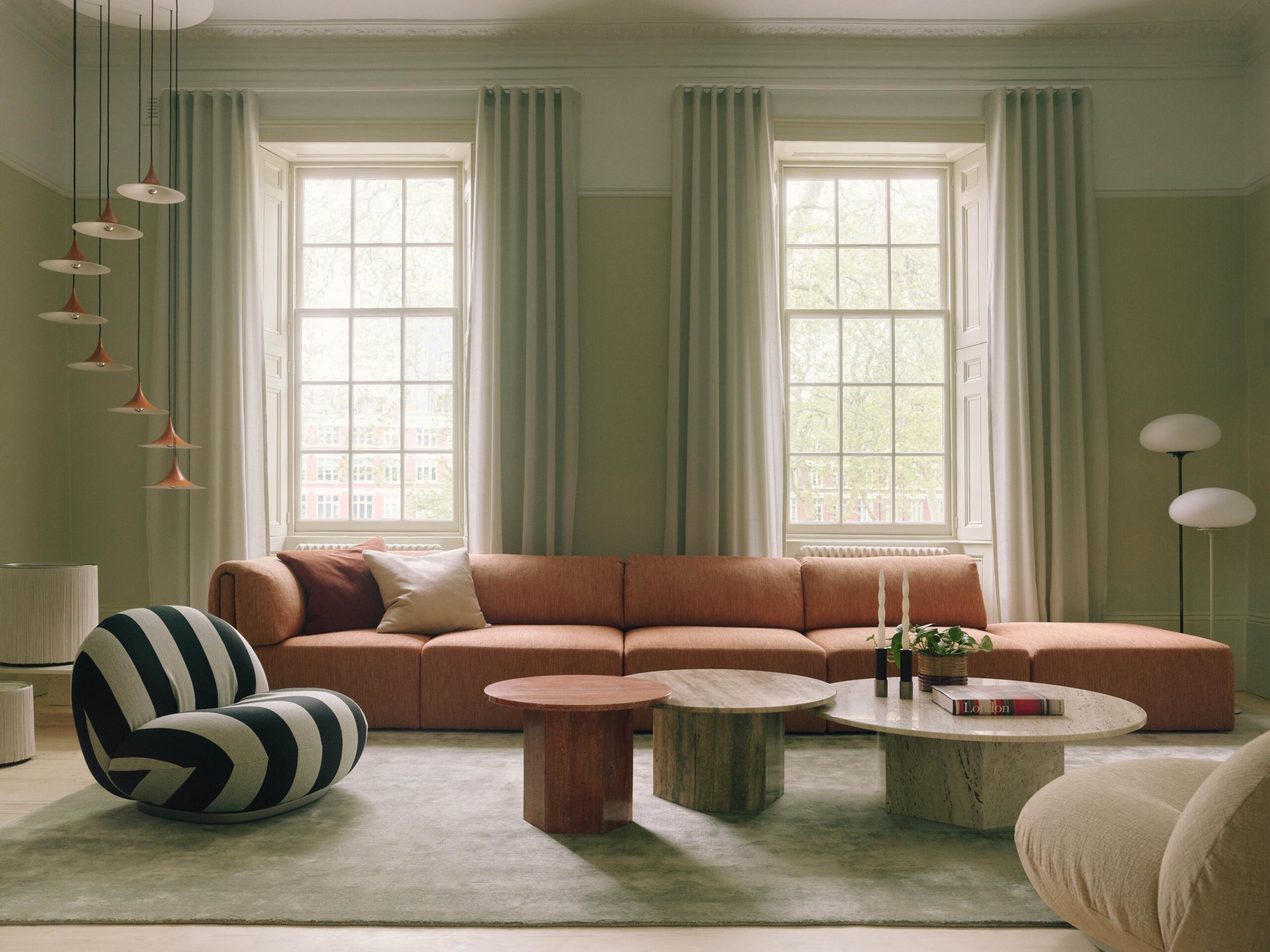 Adjaye in his Marylebone digs: not a new start but a natural progression|The reception at Edison House plays on the building’s industrial past|Adjaye has retained the original brick and render of Edison House’s art deco facade|The building’s interior: Manhattan Loft Company have taken up residence|Artists Tim Noble and Sue Webster’s home and studio, Dirty House (2002)|Sunken House in north London (2007), a prefab building made from timber|Rivington Place (2007), a new public arts venue for east London|Skolkovo, the Moscow School of Management, which was completed last year*||
Adjaye in his Marylebone digs: not a new start but a natural progression|The reception at Edison House plays on the building’s industrial past|Adjaye has retained the original brick and render of Edison House’s art deco facade|The building’s interior: Manhattan Loft Company have taken up residence|Artists Tim Noble and Sue Webster’s home and studio, Dirty House (2002)|Sunken House in north London (2007), a prefab building made from timber|Rivington Place (2007), a new public arts venue for east London|Skolkovo, the Moscow School of Management, which was completed last year*||
A firmly established international practice, Adjaye Associates’ recent move from dirty-cool Hoxton to swish Marylebone marks more than just a geographical upswing – while Adjaye himself is as self-assured as ever
The inside of David Adjaye’s new office feels a bit like the outside of his earliest residential buildings in London’s east end: dark, compact… slightly brooding. The effect is part architecture studio, part boutique hotel lobby (the sort that might play a soundtrack of ambient drum ’n’ bass).
The walls are a slate grey. Leather banquettes are under-lit with slices of yellow light. It’s only the chaotic piles of material samples on the path from the front door to the reception desk that remind you where you are: the studio of one of Britain’s most prolific contemporary architects.
The space resides in Marylebone’s Edison House, a renovated art deco storage depot turned office block. It’s been done up for Manhattan Loft Corporation by Adjaye, who while he was at it fitted out an adjoining space on the ground floor for his practice’s new home, adding to hubs in Berlin and New York.
“It’s in a very residential area and one of the last storage-type depot buildings around here,” Adjaye enthuses during the 19-minute interview onoffice managed to snag with the busy architect. “Usually something like this would come down and something flexible or a housing scheme would be built. So in doing this project, I wanted to enjoy the massive, concrete block-and-beam structure of the building.”
It’s significant that Adjaye has moved his award-winning practice from the grotty heart of Hoxton, where it was stationed for more than a decade, to the rather more stately Marylebone.
His accomplished career has reaped international commissions like the Nobel Peace Center in Oslo and Skolkovo, the Moscow School of Management that opened last year, but his architectural roots are firmly in the East End. Though, after getting Adjaye Associates back on track after a fairly serious spot of financial trouble three years ago, perhaps it’s as good of a time as any for pastures new.
“I wouldn’t call it a new start. It’s more of a natural progression,” Adjaye corrects.
As a teenager he had his first part-time job around the corner, so in a way it’s a bit like coming full circle. “I’ve always been a big fan of Marylebone; there is something about it that I’ve always enjoyed. So, considering the growth of the company, and the opportunities that have come to us, it just feels like the right time to make another jump.”
It’s been 11 years since Adjaye Associates opened for business in “one of those sweatshops” in Swanfield Street, just behind Tower Hamlets town hall.
It was from this modest shed that the architect first made his name with a series of modernist houses for artists like Turner Prize-winner Chris Ofili, part of the YBA clique who glamorised Hoxton and Shoreditch at the end of the 1990s.
A notable chunk of Adjaye’s portfolio going back to 2000 is in rough, overlooked bits of east, north east and south east London: Elektra House and later the Idea Store in Whitechapel (shortlisted for the Stirling Prize in 2006); Rivington Place, a gallery in Shoreditch; the Bernie Grant Art Centre in Tottenham and the ill-fated Stephen Lawrence Centre in Deptford.
Adjaye’s architecture has left a distinct imprint on certain areas of the capital, and in some cases played a major role in gentrifying them. Dirty House – his monolith of matt-black brick and timber for artists Tim Noble and Sue Webster – was one of the buildings to set the tone for Shoreditch’s transformation from a down-at-heel neighbourhood into what it is now.
“When I started to use dark colours it was a way to regress a bit… it was supposed to say “I’m just going to be in the background’”
“The funny thing is when I started to use dark colours on buildings, it was a way to move backwards, to regress a bit, to be softer. It’s sort of become a little bit trendy now, a kind of statement, which is a bit of an irony because I meant it to be the other way around. It was supposed to say, ‘I’m just going to be in the background’,” Adjaye chuckles.
In a similar way the refurbishment of Edison House also has an inherent reserve. It’s meant to be an anti-icon. There are no exaggerated canopies or forms and the original brick and render facade has been retained, Adjaye points out.
“I was touched and struck by the building’s substantial structure. It’s this monumental concrete,” he says. “I’m very passionate about an idea I first had with the Dirty House, which is what I call a 21st-century approach to restoration. It’s not to try to find something picturesque about an era that you go back to but to actively freeze the things you think are important. And then you make a symbiotic relationship with new materiality, but one that doesn’t overwhelm, that contributes to a sense of understanding of the past but also the feeling that you are definitely in your own time and not a period pastiche.”
In that vein the constructive design of Edison House’s main reception (not the one used for the architect’s own studio) is meant to be a reminder of the building’s industrial past, but the space has typical Adjaye flourishes; existing concrete columns and floors, haphazard punched-out windows and a reception desk made from stacked geometric slabs of marble.
Adjaye’s background gives him a unique perspective on London as a living, breathing entity. The son of a Ghanaian diplomat, he was born in Tanzania and moved around Africa for the better part of his childhood, attending international schools.
Arriving in England in 1979 when he was 13 years old (it’s often misreported that he was 9 or 10) was a bit of a shock.
“People hadn’t really heard of anybody from abroad. We were laughed at for being different. Me and my brother tried desperately to learn north London accents as quickly as we could,” he chuckles.
He grew in to adulthood with the city: “I think I’ve seen London change from a quite introverted city to becoming a really cosmopolitan city – it’s been fascinating to watch it evolve,” he says.
As a teenager he haunted the bars and clubs in Camden, and later Portobello and Notting Hill before they became gentrified enclaves. “I travel so much and whenever I come back, I really treasure its cosmopolitan identity and how it can be a face to many different people, but at the same time retain an inherently London, British quality. There’s something really powerful about that.”
As one would expect Adjaye’s special relationship with London has had an influence on his buildings, which in 2007 saw him awarded an OBE for services to architecture.
After finishing at the Royal College of Art in 1993, he markedly drew on aspects of African culture (such as shopping in an outdoor market) as inspiration for his building designs.
“It’s London’s ability to absorb things that has allowed me to be more confident about tapping into my own roots and seeing them as a contribution,” he shares.
This was underlined in 2006 at Making Public Buildings, an exhibition at the Whitechapel Gallery drawing parallels between his building projects and a smorgasbord of African handicrafts – to mixed reviews.
“I’m what one writer (Taiye Tuakli-Wosornu) called an Afropolitan – I’m a person of African descent who lives in the world and I’m influenced by things in the world, but I’m also influenced by my roots,” he says.
A point that leads to the inevitable elephant in the room: the fact that Adjaye is a young(ish) black architect in an old, white man’s profession.
“Yeah, which is ironic because the fact that I’ve been able to turn it around is now being used as a criticism for the work I’ve been doing,” he says, referring to people who quietly suggest that he’s won jobs because of tokenism – particularly in the case of the National Museum of African American History for the Smithsonian Institute in Washington DC, due to complete in 2015 to the tune of £300m.
“It’s now seen as an advantage I’ve made. So every white person who has an advantage in being in a white culture – that’s not an issue?” He chuckles again.
It goes without saying that the industry’s inclination to label him ‘young, black and charming’ grates on his nerves. “You can’t win. I’ve given up trying to understand that logic and mentality. The bottom line is if I were simply winning work because of the colour of my skin, I wouldn’t be here. I would’ve gone by now and it would’ve happened a long time ago.”
On the contrary, Adjaye appears to have persevered beyond his detractors, particularly those from the first few years when the work came flooding in.
He’s learned a few important lessons about running an architecture business as well, which he admits he needed.
“In the beginning it really was an architecture firm full of architects with not much business acumen,” he says. “We’ve realised that we can’t rely on any singular market and that we need to diversify our portfolio.”
To avoid putting the eggs in one basket, the focus will continue to be a mix of commercial and public buildings in the UK and around the globe. Add that to the new office in Old Marylebone Road, with its purpose-designed interiors, and it seems pretty clear that Adjaye isn’t going anywhere.




















